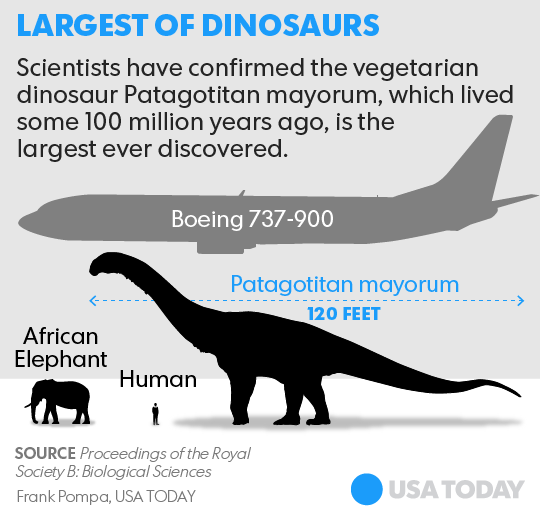It’s official: an Argentine dinosaur as heavy as a Boeing 737 is the biggest ever discovered.
The behemoth weighed more than 65 tons and perhaps as many as 77, a new study says. That makes the animal not just the biggest known dinosaur but also the biggest known land animal ever. Only a few whale species are heftier — and this dinosaur’s bones show it was still growing.
Scientists have named the gigantic vegetarian Patagotitan mayorum, in honor of the Argentine region of Patagonia and the Mayo family, owners of the Patagonian farm where a worker found the fossil in 2010. The titan of Patagonia is described in scientific detail for the first time in this week’s Proceedings of the Royal Society B: Biological Sciences.
“I don’t think the record we have now will hold forever,” says study co-author Diego Pol of Argentina’s Egidio Feruglio Museum of Paleontology. But “so far, we don't have any others dinosaurs as big as Patagotitan.”
Pol and his colleagues excavated fossils of six different Patagotitan specimens from the Mayo family farm. The 150 bones include examples of 30% of the animal’s skeleton, which to scientists is almost as mind-boggling as the animal’s weight.
“This is clearly a very, very large animal, and there’s a lot of it, and that’s an extremely rare thing as these animals go,” says Matthew Lamanna of the Carnegie Museum of Natural History, who was not involved in the find.
Patagotitan, which lived some 100 million years ago, was sociable. The six specimens found at the Mayo ranch were found in a cluster, and several had died at roughly the same time. So Patagotitan seems to have returned repeatedly to particular sites, perhaps drawn by water or food.
The finding also suggests “they could be hanging around in groups,” perhaps to look after young, says Roger Benson of Britain’s University of Oxford, who wasn’t involved with the study. But how animals as long as the space shuttle maneuvered around each other “is really hard to imagine.”
When Pol and his colleagues built a family tree of Patagotitan and other titanosaurs, they found that almost all of the family’s colossal members were close kin. And most appeared roughly 100 million years ago in South America. At the time, the climate was warmer and there were flowering plants. That may have helped dinosaurs that needed perhaps 1,000 kilod of food a day.
“We don’t have bones that are much larger than these titanosaurs,” Pol says. It’s likely that a lucky scientist will someday find an animal larger than Patagotitan, but “it seems we may be getting closer to the maximum possible body size.”
You can also watch the video by clicking on the Play Button

